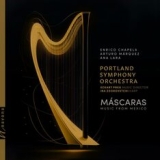Elf Minuten können lang sein, wenn nichts wirklich Sonnendes passiert in einer lauten und rhythmischen, etwas chaotischen Musik. Der Aufmacher dieses Programms, Rotor des Mexikaners Enrico Chapela (*1974) ist nicht gerade das Interessanteste Stück, das man sich vorstellen kann.
Es folgt das Harfenkonzert Máscaras von Arturo Márquez (*1950), das mit einem lieblichen Adagio beginnt, gefolgt von einem tänzerischen zweiten Satz. Der dritte Satz ist eine elegische Hommage an das Massaker von Acteal, bei dem 45 Menschen von einer paramilitärischen Gruppe mit dem Namen Rote Maske getötet wurden. Der Komponist sagt: « In diesem Jahr unterhielt ich mich mit einem kleinen Indianermädchen aus Chiapas, das mir von seiner Verbundenheit mit der Natur in Form einer Blume erzählte. » Diese Blume soll die Getöteten musikalisch ehren. Der 4. Satz behandelt eine komplexe Thematik bezüglich der Zapatistische Armee der Nationalen Befreiung. Diese Inhalte muss der Hörer aber nicht kennen, um das an sich schöne und gefällige Harfenkonzert zu genießen.
Angeles de Llama y Hielo (Engel der Flamme und des Eises) von Ana Lara beschwört kraftvolle Bilder von vier Engeln (Dunkelheit, Morgendämmerung, Licht und Sonnenuntergang) herauf, inspiriert von einem Holzschnitt Albrecht Dürers.
Die Musik wechselt von den düster brodelnden Unterwelt-Klangen des ‘Engels der Dunkelheit’ zu den viel zarteren, nebeligen, schließlich immer quirligeren und aufstrebenden Texturen des ‘Engels der Dämmerung’.
Mit dem ‘Engel des Lichts’ erreicht das Werk ganz sonor seinen Zenit. Mit dem ‘Engel der Dämmerung’ geht es dann wider bergab. Die Komponistin sagt: « Dieser letzte der vier Engel endet dort, wo der erste beginnt: So will die Musik die Idee ausdrücken, dass das Leben der Anfang des Todes ist und dass der Tod zugleich Anfang und Ende ist. »
Die drei Werke werden vom Portland Symphony Orchestra unter Eckart Preu auf solidem Niveau aufgeführt.
Eleven minutes can be long if nothing really sunny happens in loud and rhythmic, somewhat chaotic music. The opener of this program, Rotor by Mexican composer Enrico Chapela (*1974), is not exactly the most interesting piece imaginable.
It is followed by the harp concerto Máscaras by Arturo Márquez (*1950), which begins with a lovely adagio, followed by a dance-like second movement. The third movement is an elegiac homage to the Acteal massacre, in which 45 people were killed by a paramilitary group called the Red Mask. The composer says: « That year I talked to a little Indian girl from Chiapas who told me about her connection with nature in the form of a flower. » This flower is a musical tribute to those who have been killed. The 4th movement deals with a complex subject relating to the Zapatista Army of National Liberation. However, the listener does not need to know this content in order to enjoy this beautiful and pleasing harp concerto.
Angeles de Llama y Hielo (« Angels of Flame and Ice ») by Ana Lara conjures up powerful images of four angels (darkness, dawn, light and sunset), inspired by a woodcut by Albrecht Dürer.
The music shifts from the dark, bubbling underworld sounds of the ‘Angel of Darkness’ to the much more delicate, foggy, ultimately increasingly lively and soaring textures of the ‘Angel of Dawn’.
With the ‘Angel of Light’, the work sonorously reaches its zenith. It then goes downhill again with the ‘Angel of Twilight’. The composer says: « This last of the four angels ends where the first begins: this is how the music wants to express the idea that life is the beginning of death and that death is both the beginning and the end. »
The three works will be performed by the Portland Symphony Orchestra under Eckart Preu at a solid level.
























